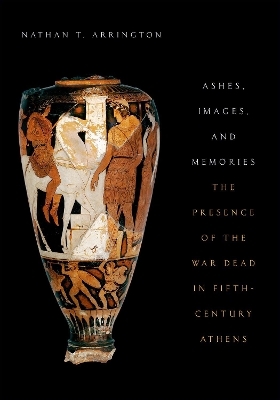
Ashes, Images, and Memories
The Presences of the War Dead in Fifth-Century Athens
Seiten
2019
Oxford University Press Inc (Verlag)
978-0-19-093669-3 (ISBN)
Oxford University Press Inc (Verlag)
978-0-19-093669-3 (ISBN)
This book explores how the institution of public burial for the war dead and images of the deceased in civic and sacred spaces fundamentally changed how Athenians conceived of military casualties, and traces the ways in which people responded through material culture.
Ashes, Images, and Memories argues that the institution of public burial for the war dead and images of the deceased in civic and sacred spaces fundamentally changed how people conceived of military casualties in fifth-century Athens. In a period characterized by war and the threat of civil strife, the nascent democracy claimed the fallen for the city and commemorated them with rituals and images that shaped a civic ideology of struggle and self-sacrifice on behalf of a unified community.
While most studies of Athenian public burial have focused on discrete aspects of the institution, such as the funeral oration, this book broadens the scope. It examines the presence of the war dead in cemeteries, civic and sacred spaces, the home, and the mind, and underscores the role of material culture - from casualty lists to white-ground lekythoi-in mediating that presence. This approach reveals that public rites and monuments shaped memories of the war dead at the collective and individual levels, spurring private commemorations that both engaged with and critiqued the new ideals and the city's claims to the body of the warrior. Faced with a collective notion of "the fallen" families asserted the qualities, virtues, and family links of the individual deceased, and sought to recover opportunities for private commemoration and personal remembrance. Contestation over the presence and memory of the dead often followed class lines, with the elite claiming service and leadership to the community while at the same time reviving Archaic and aristocratic commemorative discourses. Although Classical Greek art tends to be viewed as a monolithic if evolving whole, this book depicts a fragmented and charged visual world.
Ashes, Images, and Memories argues that the institution of public burial for the war dead and images of the deceased in civic and sacred spaces fundamentally changed how people conceived of military casualties in fifth-century Athens. In a period characterized by war and the threat of civil strife, the nascent democracy claimed the fallen for the city and commemorated them with rituals and images that shaped a civic ideology of struggle and self-sacrifice on behalf of a unified community.
While most studies of Athenian public burial have focused on discrete aspects of the institution, such as the funeral oration, this book broadens the scope. It examines the presence of the war dead in cemeteries, civic and sacred spaces, the home, and the mind, and underscores the role of material culture - from casualty lists to white-ground lekythoi-in mediating that presence. This approach reveals that public rites and monuments shaped memories of the war dead at the collective and individual levels, spurring private commemorations that both engaged with and critiqued the new ideals and the city's claims to the body of the warrior. Faced with a collective notion of "the fallen" families asserted the qualities, virtues, and family links of the individual deceased, and sought to recover opportunities for private commemoration and personal remembrance. Contestation over the presence and memory of the dead often followed class lines, with the elite claiming service and leadership to the community while at the same time reviving Archaic and aristocratic commemorative discourses. Although Classical Greek art tends to be viewed as a monolithic if evolving whole, this book depicts a fragmented and charged visual world.
Nathan T. Arrington is an Associate Professor of Classical Archaeology at Princeton University.
Acknowledgements
Introduction - "To see them so changed would be their death."
Chapter 1 - Mass Ashes: The Origins and Impact of an "Ancestral Custom"
Chapter 2 - The Topography and Phenomenology of the Public Cemetery
Chapter 3 - Naming the Dead: Casualty Lists and the Tenses of Commemoration
Chapter 4 - Sacred Space and the Fallen Warrior
Chapter 5 - Private Engagement with Civic Death: Portrait Statues, Votive Reliefs, and Wall Paintings
Chapter 6 - More Than a Name: Private Commemoration in Attic Cemeteries
Chapter 7 - The Limits of Commemoration
Conclusion
Bibliography
Index
| Erscheinungsdatum | 04.12.2018 |
|---|---|
| Zusatzinfo | 85 illus. |
| Verlagsort | New York |
| Sprache | englisch |
| Maße | 231 x 163 mm |
| Gewicht | 635 g |
| Themenwelt | Kunst / Musik / Theater ► Kunstgeschichte / Kunststile |
| Geisteswissenschaften ► Geschichte ► Allgemeines / Lexika | |
| Geschichte ► Allgemeine Geschichte ► Vor- und Frühgeschichte | |
| Geschichte ► Allgemeine Geschichte ► Altertum / Antike | |
| ISBN-10 | 0-19-093669-X / 019093669X |
| ISBN-13 | 978-0-19-093669-3 / 9780190936693 |
| Zustand | Neuware |
| Haben Sie eine Frage zum Produkt? |
Mehr entdecken
aus dem Bereich
aus dem Bereich
auf den Spuren der frühen Zivilisationen
Buch | Hardcover (2023)
C.H.Beck (Verlag)
20,00 €
Konzepte – Methoden – Theorien
Buch | Softcover (2024)
UTB (Verlag)
39,90 €
Was Pompeji über uns erzählt
Buch | Hardcover (2023)
Propyläen (Verlag)
32,00 €


